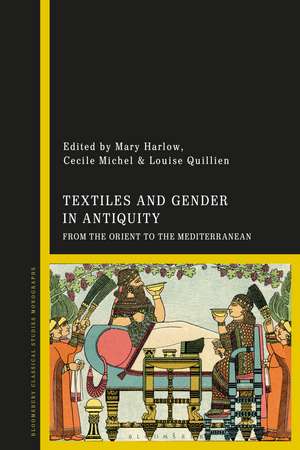Textiles and Gender in Antiquity: From the Orient to the Mediterranean
Editat de Professor Mary Harlow, Cecile Michel, Louise Quillienen Limba Engleză Paperback – 18 mai 2022
| Toate formatele și edițiile | Preț | Express |
|---|---|---|
| Paperback (1) | 200.61 lei 6-8 săpt. | |
| Bloomsbury Publishing – 18 mai 2022 | 200.61 lei 6-8 săpt. | |
| Hardback (1) | 776.65 lei 3-5 săpt. | |
| Bloomsbury Publishing – 11 noi 2020 | 776.65 lei 3-5 săpt. |
Preț: 200.61 lei
Preț vechi: 259.39 lei
-23% Nou
Puncte Express: 301
Preț estimativ în valută:
38.40€ • 39.50$ • 31.86£
38.40€ • 39.50$ • 31.86£
Carte tipărită la comandă
Livrare economică 19 februarie-05 martie
Preluare comenzi: 021 569.72.76
Specificații
ISBN-13: 9781350189737
ISBN-10: 1350189731
Pagini: 328
Ilustrații: 82 bw illus and 16 colour illus
Dimensiuni: 156 x 234 mm
Greutate: 0.49 kg
Editura: Bloomsbury Publishing
Colecția Bloomsbury Academic
Locul publicării:London, United Kingdom
ISBN-10: 1350189731
Pagini: 328
Ilustrații: 82 bw illus and 16 colour illus
Dimensiuni: 156 x 234 mm
Greutate: 0.49 kg
Editura: Bloomsbury Publishing
Colecția Bloomsbury Academic
Locul publicării:London, United Kingdom
Caracteristici
Synthesizes material from the ancient world at its widest and longest, from 3000 BC to Late Antiquity, and including Egypt and the Near East as well as the Classical world
Notă biografică
Mary Harlow is an Associate Professor in Ancient History at the University of Leicester, UK. She has published extensively on Roman dress and has been an editor and contributor to several of Bloomsbury's Cultural History series including Children and the Family (2010), Dress and Fashion (2017), Hair (2018) and Shopping (2019). Cécile Michel is a Senior Researcher at CNRS, Archéologie et Science de l'Antiquité, France and Professor of Assyriology at Hamburg University, Germany. She has published books and studies on women, gender studies and ancient textiles including Textile Terminologies (2010 and 2017) Wool Economy in the Ancient Near East and the Aegean (2014) and The Role of Women in Work and Society in the Ancient Near East (2016).Louise Quillien is a Researcher at CNRS, Archéologie et Science de l'Antiquité, France. She defended her PhD on Textiles in Mesopotamia, 1st millennium BC: manufacturing techniques, trade and uses in 2016.
Cuprins
1. Textiles and Gender in Antiquity: An IntroductionMary Harlow (Leicester, UK), Cécile Michel (CNRS, ArScAn, Nanterre, France) and Louise Quillien (Paris 1 Panthéon-Sorbonne, France)Gendered Textile Terminologies2. Textiles and Gender during the Middle Babylonian Period (ca. 1500-1000 BCE): Texts from Syria and BabyloniaPhilippe Abrahami (Independent Scholar, France) and Brigitte Lion (Paris 1 Panthéon-Sorbonne, France)3. The Goddess Nanaja's New ClothesFrancis Joannès (Paris 1 Panthéon-Sorbonne, France)4. Textiles and Gender at UgaritValérie Matoïan (CNRS, Proclac, France) and Juan-Pablo Vita (Independent Scholar, Spain)5. Towards Engendering Textile Production in Middle Bronze Age CreteAgata Ulanowska (Independent Scholar, Poland)Gendered Textile Activities6. A Man's Business? Washing the Clothes in Ancient Egypt (Second and First Millennia BCE)Damien Agut-Labordère (CNRS, France)7. Women, Men, Girls and Boys: Gendered Textile Work at Late Bronze Age KnossosHedvig Landenius Enegren (Independent Scholar, Uppsala)8. Female Dues and the Production of Textiles in Ancient Greece Beate Wagner-Hasel (Independent Scholar, Germany)9. Gender and Textile Production in Roman Society and PoliticsLena Larsson Lovén (Independent Scholar, Germany)10. Work Gendering Space? Roman Gender, Textile Work and Time in Shared Domestic SpaceMagdalena Ohrman (University of Wales, UK)Gendered Wardrobes11. Some Remarks on Textiles and Gender in the Ebla Texts of the 3rd Millennium BCEMaria Giovanna Biga (Rome, La Sapienza, Italy)12. A Visual Investigation of Feminine Garments at Mari During the Early Bronze AgeBarbara Couturaud (Institut Français du Proche-Orient, Iraq)13. Belts and Pins as Gendered Elements of Clothing in Third and Second Millennia MesopotamiaCécile Michel (CNRS, ArScAn, France)14. 'I made you put on garments, I made you dress in linen.' Gender Performance and Garments in Sumerian Literature Anne-Caroline Rendu Loisel (Unistra, Strasbourg, France)15. The Gender of Garments in First Millennium BCE Mesopotamia: An Inquiry Through Texts and IconographyLouise Quillien (Paris 1 Panthéon-Sorbonne, France)16. White Men and Rainbow Women: Gendered Colour Coding in Roman Dress Cecilie Brøns (Ny Carlsberg Glyptotek, Denmark) and Mary Harlow (Leicester University, UK)17. Garments for Potters? Textiles, Gender and Funerary Practices in Les Martres-de-Veyre, France (Roman Period)Catherine Breniquet (Clermont-Auvergne, France ), Marie Bèche-Wittman, Christine Bouilloc and Camille Gaumat (Musée Bargoin, Clermont-Ferrand, France)18. Fashioning the Female in the Early North African ChurchAmy Place (Leicester University, UK)19. Climate Change and Clothing Changes in Late Antique Male DressNikki K. Rollason (Leicester University, UK)Afterwords20. A Note on Gender and French 'Haute Couture' in 1970: 'Les Sumériennes' by Jacques EstérelBrigitte Lion (Paris 1 Panthéon - Sorbonne, France)21. Concluding RemarksEva Andersson Strand (Independent Scholar, Denmark)NotesBibliographyIndex
Recenzii
[Textiles and Gender in Antiquity] is a great resource for in depth knowledge and studies of Antiquity, textiles, and gender.
This essential volume provides a much-needed study of textiles, dress, and gender in the ancient world. With its wide chronological and geographical range, it provides students and scholars with useful information from the ancient Near East to late antique Rome in a series of essays that look not only at clothing and textile production, but also at how these categories were almost always cast in terms of gender in antiquity.
This essential volume provides a much-needed study of textiles, dress, and gender in the ancient world. With its wide chronological and geographical range, it provides students and scholars with useful information from the ancient Near East to late antique Rome in a series of essays that look not only at clothing and textile production, but also at how these categories were almost always cast in terms of gender in antiquity.
